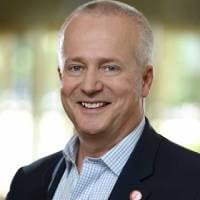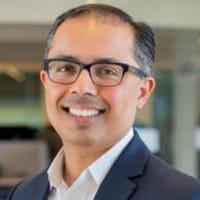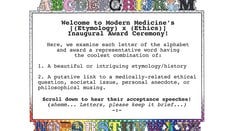Recorded 11/6/2022 This transcript has been edited for clarity.
Robert A. Harrington, MD: Hi. I'm Bob Harrington from Stanford University, here at the American Heart Association (AHA) meeting in Chicago. I'm on theheart.org | Medscape Cardiology.
During the course of many of these interviews over the years, we touch upon a lot of topics. We talk about science, hot topics, or controversial topics in the world of cardiovascular medicine.
Today, I have one that I hope, in particular, my mid-career and senior colleagues will take a careful listen to. I've been intrigued, at this point in my own career, at people making decisions to do something else than what I'll call traditional academic or clinical medicine. What are some of those other things you can do?
At this meeting, I happened to run into two really good friends and close colleagues. I asked them to sit with me for 10 or 15 minutes and talk to me about why they recently made a decision, in this case, to move from academic medicine to industry — one into the technology sector and one into the biopharma sector.
I'm really pleased to be joined today by Mintu Turakhia. Mintu is a professor of medicine at Stanford University. He's also the chief medical and scientific officer at iRhythm. Mintu, thanks for joining us.
Mintu Turakhia, MD, MAS: Delighted to be here. Thanks, Bob.
Harrington: Second is my very long-time friend and colleague, Dr Magnus Ohman. Magnus is formerly a professor of medicine at Duke and he's now a VP of Global Development in Cardiometabolic at Amgen. Magnus, thanks for joining us.
Magnus Ohman, MD: It's great to be here with you again, Bob.
Harrington: Don't worry, Magnus, I'm not going to tell all those stories of when you and I were young faculty members. I'm just going to concentrate on being senior faculty members.
Ohman: That is very good. I'm looking forward to this.
From Academic Medicine to the Other Side of the Fence
Harrington: Let me start with you, Magnus, because you and I chat regularly. You have been an academic cardiologist for a long time, I would say, really, at the height of academics. You lead many studies. You're a revered clinician. Patients come from all over the place to see you. You're a successful fundraiser. Every box is ticked for you in academic medicine: leader, researcher, educator, administrator. You've been a chief of cardiology. Why make this jump now?
Ohman: Well, I think you just ticked all the boxes. The way I saw it is that this was an opportunity to go back to clinical trials but do it on the other side of the fence. Clinical trials are very frequently carried out by academic research organizations, or CROs. I have really enjoyed those years that I have done that.
I saw this opportunity to learn new things on the other side of the fence. There are many differences, but yet the outcomes that we want to achieve are better outcomes for our patients, better outcomes, better trials, and in that realm, things are aligned. We can do better.
Harrington: One of the things you gave up, so to speak, is clinical medicine. Not only did I work side-by-side with you in the cath lab for years, I was, in part, trained by you. You're a superb interventional cardiologist, a great clinician who ran the Advanced Coronary Disease program at Duke for many years. How did you give up clinical practice?
Ohman: Well, that is the harder part. I have to give credit to my wife, Elspeth. I was really uncertain about this because, yes, you're right, to be a clinician and work hard in clinical medicine and then say goodbye to your patients, it's a hard step to take. I think everybody frets a little bit about this.
My wife, who's Irish, as you know, she said, "What are you worried about? At some point, you're going to have to give them up. You have to say goodbye at some point. Why not do that in a controlled manner where you actually can organize it, set all the patients up with your cardiologist friends, and they can get well taken care of?"
For me, she gave the answer to that specific question. At some point, we all have to do it. I just did it a little bit earlier. Yes, patients might be upset or concerned, but once you provide a home for them and some way of going forward, they're okay with it — at least the ones that I have taken care of.
Harrington: Boy, there are so many things to unpack there. First, I am not surprised. I've also known your wife for decades. To get wise advice would be not unexpected, I would say. There are many things that we're going to come back to.
Let me ask you, Mintu. You're at a different stage of career than Magnus. You've only recently become a professor. You're enormously successful. I would say that your star has been on the rise in academic medicine. You've already led some amazing tech-oriented projects in cardiovascular medicine. As both your former and current chair of medicine, I about cried when you told me that you were going. Why'd you decide to do it?
Turakhia: Yes, it's a great question. In my case, I have not checked all the career boxes. There was an enormous runway and a huge trajectory for the things I learned. It was great. There was no better job that I could have thought of. I wasn't looking. I was focused on what we were doing, all the great work that you know about across atrial fibrillation, clinical trials, health technology, and the Center for Digital Health that we put together. It was great.
The opportunity snuck up on me and came to me. It was an opportunity to take all of that and lead a relatively small public company at a period where there are huge table stakes and opportunity in front of it to really grow, expand, and scale. For me, it was an opportunity to work specifically with a CEO who is just really good, where I could learn many additional skills on my professional development path.
It wasn't because I wasn't fulfilled, happy, and productive. It was an opportunity that, when you look at what I can do and the ability to lead an organization, a corporation, help guide it through a process of change with a new CEO who's done this, from whom I can learn so much. The way I felt about it was here is an opportunity to develop a highly translatable skill set in executive leadership, organizational change, and change management that happens to be aligned with the things I care about and work on — atrial fibrilation, health technology, digital health, software, and artificial intelligence (AI). Also, the opportunity to own all of those areas where we can go fast and take the science that we do, deliver the science, and do it from the other side, as Magnus said, but also to think of how we can innovate on the products.
That was the framework that I had. I went through a whole process of decision making and using frameworks that we can talk about as well. It was, really, as I see it, part of a journey as a clinician and a scientist where those skills could be brought right back.
Keeping a Hand in the Clinic
Harrington: You both had some things I want to go back to. You've both spoken, I think as one of your early comments, about continuing to learn. It's a topic I want to come back to, so start thinking about that. I also want you to think about the opportunity to educate and maybe in a different format.
Mintu, I mentioned that Magnus retired from Duke. He stepped aside and said goodbye to his patients. You didn't retire. You're on a leave of absence. What's the difference?
Turakhia: I think that's relevant to the audience here. There are many forms of doing this. There are sabbaticals, leaves of absence, and clean breaks. What we are very fortunate to have at Stanford is a supportive environment, and I think, most importantly, a culture where we can do this. I'm not the first. There are many before me, both in the School of Medicine and in other schools at the university, who've done this, with the idea that you can take a little bit of a detour and learn some skills, see how those culminate in your life, and then determine how you intend to take that and bring them back.
The other part that Magnus touched on was patient care. In my own professional and clinical journey, I'm not ready to give that up yet. The way I address this is, I started in June, as you know. I went head down, 4 months, focused on that, no clinical anything. I also wanted to see how that felt. We obviously had great clinical transition plans and leadership plans that you and I and others worked on.
The patients were getting good care. We had planned all that. I missed the clinical work. What I'm in the process now is at the VA, while on Stanford leave, reengaging back in the electrophysiology (EP) lab. I would say what's really healthy is to do that under leave. You also need a culture on the side that you're joining on the other side of the fence.
Harrington: That allows that.
Turakhia: That not only allows it but that also embraces it. They actually view this as a value add for the company. This is not like giving Mintu clinical time, as you would give someone time to play golf. This actually adds to my role and purpose.
Harrington: I only smile because Magnus is one of the biggest golfers I know.
Magnus, let me jump back to you. You said something interesting: "I want to learn new things." You and I had offices next door to each other for decades. I look at you as one of the world's best clinical trialists and best clinical researchers. What do you have left to learn?
Ohman: All of us know that clinical trials can be done better. I see my role as taking some of the things that I learned in the academic sphere, and within the corporate sphere, saying, "Okay, so this is what we traditionally do, but there are other ways." Part of it has been through my exposure, through the FDA and other agencies that I've been involved with, I've learned that there are better and simpler ways to do things to get an answer.
Part of it is, of course, having faith that you can deliver on that. My hope is that I will for Amgen, and actually bring out new ideas that we can tackle in the clinical trials arena because I think that's so important. Trials are getting more and more expensive. We really have to break it and simplify it and make it work.
While I'm learning many things, mostly about forecasting and all these other things that I didn't know much about before, I'm also hoping that I'm bringing things of value to the clinical trials operation.
Goodbye to Teaching and Mentoring
Harrington: It's nice you get the two sides together.
Mintu, I'm going to ask you a different part of learning, and that's the teaching part. At Stanford, you are one of the most popular mentors in the Department of Medicine. Already, you've trained many people, including some of our junior faculty members. How was giving that up? You're one of the founders of our Center for Digital Health. You have a whole fellowship program at the Center for Digital Health. You have a bunch of young people who want to be like Mintu. How was it stepping away from that? Are you going to play another role in mentorship?
Turakhia: That was the hardest thing. As you know, I agonized over transitions, mentoring, who should mentor people, what do we do with these programs, and how do we support them. It was the hardest part of the entire thing. It's still hard. On the other hand, it's great to see that they're shining now and just doing great things. I'll first speak on the decision framework and then get back to the mentoring.
There are many ways to make these decisions. You obviously need to be in a culture where we can be open and choose. Again, with you being my mentor and helping guide me through these decisions, I don't think I could have done it alone. You worry about what's going to happen to the things you've built, what's going to happen to the programs that are in place, and what will happen to all those people that depend on it and all the employees you have.
Those are highly consequential things. In the whole process of self-discovery, what it finally came down to was a framework that Jeff Bezos, of all people, framed. There's a great YouTube video on this from when he decided to leave investment banking and create a bookstore out of his garage.
Harrington: Sell books.
Turakhia: Right. He calls it and it's now called the Regret Minimization Framework. The idea is if at age 80 or at the end of life or X number of years down the road, how would you feel if you didn't try this? Once I had clarity on that distillation, it was a much easier process. Because now you focus not on the inputs of the mentoring as part of the decision, but a decision around regret minimization and then a very active process to figure out the mentoring.
As you know, with your support and everyone we have also in cardiovascular medicine and the VA, the grants and the programs, in many ways, have all accelerated, I would argue. Our junior faculty have enabled them to flourish because now they're owning these programs. You look at some of our great stars here at AHA; they've done that. That's been a delight to see.
Harrington: Yes. You've done that very well. All right, we have time for about another minute. I'll give you each about 30 seconds. What is a piece of advice you'd give the audience who are going through the same career reflections? Magnus?
Ohman: I think the best thing is to — what Mintu says — basically to say, "Okay, at the end of your career, what was it that you would have wanted to do vs what you didn't do, and what are the pieces?" I think we grow, personally, much more if we try new things and try different things so that we can have a fulfilled life. Part of my thinking was around that as well, in a different format.
Harrington: Yes, and at a different stage, which I think is an important conversation — that these conversations take place mid-career, more senior career.
Mintu, what's the piece of advice you'd give the audience?
Turakhia: Have open, honest conversations with family, friends, mentors, chairs, and all the people around you. Let them know what's going on. Think through the decision framework that works for you. I mentioned one. There are others. Never try to time this. Don't go looking. These decisions come when you least expect them, and that's a good thing, but that may be leading to a willingness to understand the timing of that decision around all the other people and the consequences you can have. Once you know, time it and plan it well.
Harrington: I'm hearing from both of you that there's both opportunity and intentionality. You want to make sure that you're embracing opportunities but being very intentional about it. You both obviously gave this much thought. I'm just waiting to see what the two of you do. You're both super talented individuals.
I want to thank you for sharing your wisdom here on Medscape Cardiology | theheart.org. Our guests have been Dr Magnus Ohman and Dr Mintu Turakhia. Thank you both. Thank you to the audience for listening.
Robert A. Harrington, MD, is chair of medicine at Stanford University and former president of the American Heart Association. (The opinions expressed here are his and not those of the American Heart Association.) He cares deeply about the generation of evidence to guide clinical practice. He's also an over-the-top Boston Red Sox fan.
Follow Bob Harrington on Twitter
Follow theheart.org | Medscape Cardiology on Twitter
Follow Medscape on Facebook, Twitter, Instagram, and YouTube
Credits:
Lead Image: Martinmark/Dreamstime
© 2023 WebMD, LLC
Any views expressed above are the author's own and do not necessarily reflect the views of WebMD or Medscape.
Cite this: Robert A. Harrington, Magnus Ohman, Mintu Turakhia. The Career Pivot: Leaving Clinical Medicine for a While -- or for Good - Medscape - Jan 17, 2023.













Comments